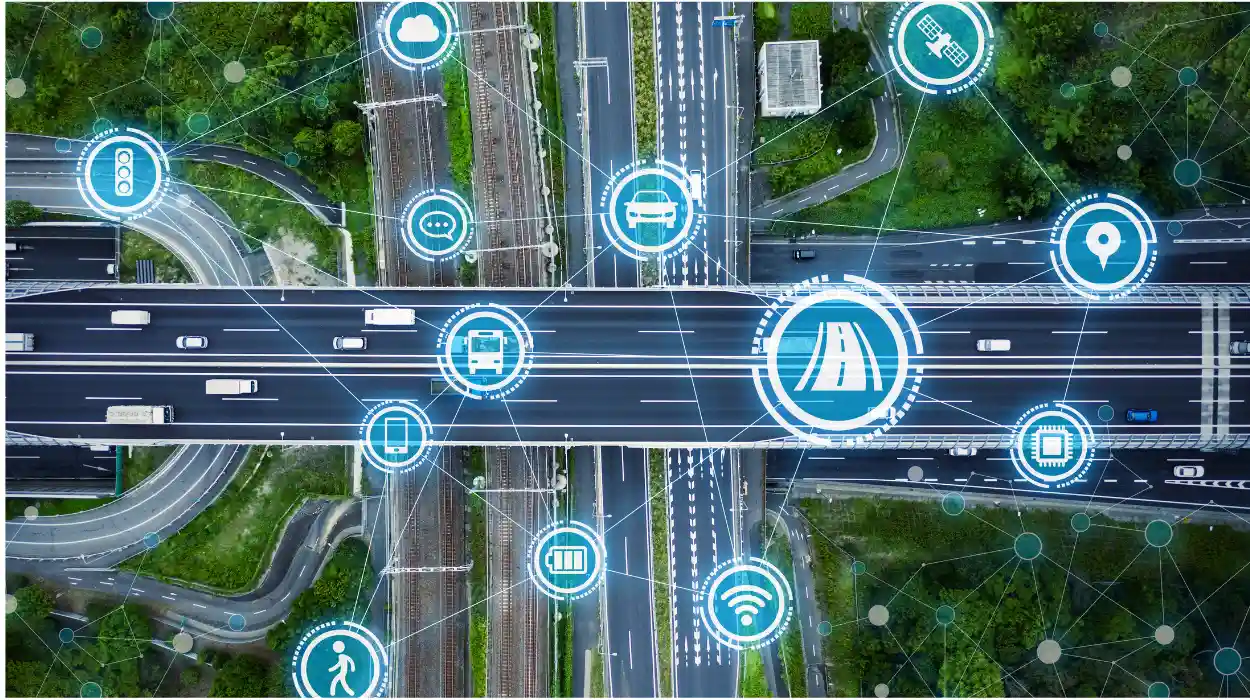The rapid evolution of smart cities is no longer a futuristic concept but a present-day reality, driven by advances in IoT systems in smart infrastructure. By 2025, the Internet of Things in urban development is reshaping how cities operate, making infrastructure more efficient, sustainable, and connected. From smart traffic lights that reduce congestion to intelligent energy grids that optimize consumption, IoT stands at the heart of digital transformation in smart cities.
This blog provides a practical guide to IoT in infrastructure management, exploring its role in transforming urban planning, enhancing efficiency, and ensuring sustainability. It also highlights key IoT applications in infrastructure management and the benefits of adopting intelligent infrastructure systems for long-term urban growth.
Understanding IoT Systems in Smart Infrastructure
The Internet of Things (IoT) refers to interconnected devices and sensors that collect, transmit, and analyze data in real time. In the context of smart infrastructure 2025, IoT enables cities to integrate transportation, energy, waste, water, and security systems into a unified, responsive framework.
Smart infrastructure powered by IoT includes:
- Smart Transportation Networks: IoT sensors optimize traffic flow and reduce congestion.
- Energy Management Systems: Smart grids monitor and adjust consumption for efficiency.
- Environmental Monitoring: IoT devices track air quality, noise, and pollution levels.
- Building Automation: Intelligent infrastructure systems manage lighting, heating, and security.
The result is improved functionality, reduced costs, and stronger sustainability in modern cities.
The Role of IoT in Smart Cities
1. Enhancing Connectivity and Efficiency
IoT creates a network of systems that communicate seamlessly. By ensuring smart infrastructure and connectivity, cities can respond faster to challenges such as traffic delays, energy shortages, or security threats.
2. Enabling Data-Driven Urban Planning
With IoT sensors generating vast amounts of information, planners can use data-driven urban planning with IoT to make informed decisions. From predicting utility demand to redesigning road networks, IoT ensures strategies are evidence-based and effective.
3. Building Sustainability with IoT Technology
Adopting IoT technology for sustainable infrastructure reduces energy waste, enhances renewable integration, and supports environmental goals. For instance, smart waste systems monitor bins and optimize collection routes, lowering emissions.
IoT Applications in Infrastructure Management
Smart Energy Grids
IoT-based solutions for future infrastructure enable real-time monitoring of energy demand, integrating renewable sources and reducing dependency on fossil fuels.
Transportation and Mobility
Smart traffic lights, ride-sharing systems, and IoT-enabled parking sensors streamline mobility while cutting emissions. This is central to how IoT is transforming smart infrastructure in 2025.
Public Safety and Security
IoT cameras and sensors enhance surveillance, disaster response, and emergency services, improving resilience in urban areas.
Water and Waste Management
Intelligent sensors track water usage, detect leaks, and ensure efficient waste collection—essential for sustainability.
These IoT applications in infrastructure management highlight how technology is shaping cities into efficient, safe, and livable spaces.
Benefits of IoT for Smart City Development
Cities adopting IoT enjoy significant advantages:
- Efficiency Gains: Automation reduces costs and enhances resource allocation.
- Sustainability: IoT minimizes waste and maximizes renewable energy integration.
- Improved Quality of Life: Citizens benefit from cleaner environments, better transport, and smarter utilities.
- Predictive Maintenance: IoT allows proactive repairs, extending infrastructure life cycles.
These are the measurable benefits of IoT for smart city development, proving its value for both governments and residents.
Practical Guide to IoT in Infrastructure Management
For cities and organizations aiming to embrace IoT, the following steps are critical:
1. Assess Infrastructure Needs
Understand existing systems and identify areas where IoT can deliver the most impact, such as energy, transport, or waste management.
2. Deploy IoT Devices and Networks
Integrate smart sensors, data platforms, and connectivity systems to enable real-time monitoring and response.
3. Prioritize Cybersecurity
With millions of devices online, safeguarding against cyber threats is essential for maintaining trust in intelligent infrastructure systems.
4. Leverage Analytics for Decision-Making
Use IoT data for coordination strategies in distributed AI systems and predictive planning, ensuring cities evolve based on accurate insights.
5. Foster Collaboration Across Sectors
Governments, private companies, and citizens must collaborate to ensure IoT adoption supports shared goals of sustainability and efficiency.
Integrating IoT Systems for Smart Urban Growth
The ultimate goal of IoT adoption is long-term, scalable urban growth. By integrating IoT systems for smart urban growth, cities can:
- Support population growth with resilient infrastructure.
- Improve operational efficiency while reducing costs.
- Enable future-ready urban development powered by sustainable practices.
As we move toward 2025 and beyond, the role of IoT in smart cities will expand further, integrating with AI, blockchain, and 5G to build ecosystems that are adaptive and intelligent.
Final Thoughts
The future of cities lies in IoT systems in smart infrastructure, where digital transformation, sustainability, and intelligent design come together. This practical guide to IoT in infrastructure management demonstrates how IoT not only enhances urban living but also ensures resilience and growth for decades to come.
For professionals seeking to advance their expertise in this rapidly evolving field, the Oxford Training Centre provides specialized IT and Computer Science Training Courses. These programs equip learners with the knowledge to design, implement, and manage IoT-based solutions for future infrastructure—skills essential to thriving in the era of smart infrastructure 2025.

